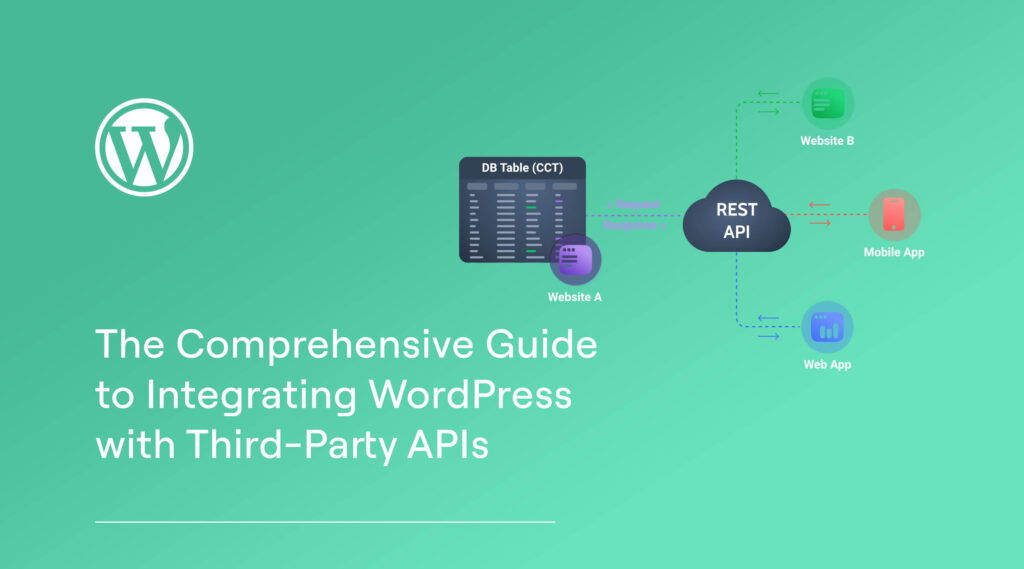WordPress is one of the most popular content management systems in the world, powering millions of websites. With its user-friendly interface and flexible architecture, WordPress is the go-to solution for many website owners. However, there may be times when you need to access your website’s data outside of the WordPress environment. That’s where the WordPress REST API comes in.
In this article, we’ll explore the WordPress REST API plugin and how it can help you access and manipulate your WordPress data. We’ll cover everything from what the REST API is, to how to install and configure the plugin, and provide some examples of what you can do with it.
What is the WordPress REST API?
The WordPress REST API is a powerful tool that allows developers to access and manipulate WordPress data via HTTP requests. With the REST API, you can perform tasks like creating and editing posts, retrieving data about users, and even creating custom endpoints for your own plugins and themes.
The REST API uses the same architecture as the WordPress admin interface, which means that you can use the same authentication and permission system that you’re already familiar with. Additionally, the REST API is designed to be extensible, which means that you can easily create your own custom endpoints to suit your needs.
Why use the WordPress REST API?
There are several reasons why you might want to use the WordPress REST API. For one, it allows you to access your website’s data from outside of the WordPress environment. This means that you can build custom front-end applications that communicate with your WordPress back-end, or integrate your website’s data with other services.
Another reason to use the WordPress REST API is that it provides a standardized interface for accessing WordPress data. This means that developers can build applications that work with any WordPress website that has the REST API enabled, regardless of how it’s configured or what plugins are installed.
How to Install and Configure the WordPress REST API Plugin
Installing and configuring the WordPress REST API plugin is a straightforward process. Here are the steps you’ll need to follow:
- Install the Plugin
The first step is to install the REST API plugin. To do this, log in to your WordPress dashboard and navigate to the Plugins section. Click the “Add New” button at the top of the screen, and then search for “REST API.” Install and activate the plugin. - Check the REST API Settings
Once you’ve installed the plugin, you’ll need to check the REST API settings to make sure they’re configured correctly. To do this, navigate to the Settings section of your WordPress dashboard and click on the “REST API” tab. Here, you can configure things like authentication settings and rate limiting. - Test the REST API
Finally, you’ll want to test the REST API to make sure it’s working correctly. One way to do this is to use a tool like Postman, which allows you to send HTTP requests and inspect the responses. Try making a simple request to retrieve some data from your WordPress website, such as a list of posts.
Examples of What You Can Do With the WordPress REST API
Now that you know how to install and configure the WordPress REST API plugin, let’s take a look at some examples of what you can do with it.
To use the WordPress REST API Plugin, you must first install and activate it. The plugin is available in the WordPress plugin repository, and you can install it like any other WordPress plugin.
Once you have installed and activated the plugin, you can use it to create custom solutions. Here are some examples of how you can use the WordPress REST API Plugin:
- Retrieving Posts
You can use the WordPress REST API Plugin to retrieve posts from your WordPress website. To do this, you need to make an HTTP request to the REST API endpoint for posts.
Here’s an example of how you can retrieve posts using the WordPress REST API Plugin:
GET /wp-json/wp/v2/posts
This will return a JSON object containing all the posts on your WordPress website.
- Creating Posts
You can also use the WordPress REST API Plugin to create posts on your WordPress website. To do this, you need to make an HTTP request to the REST API endpoint for posts.
Here’s an example of how you can create a post using the WordPress REST API Plugin:
POST /wp-json/wp/v2/posts
You will need to include the post data in the request body, including the title, content, and any other metadata you want to include.
- Updating Posts
You can use the WordPress REST API Plugin to update existing posts on your WordPress website. To do this, you need to make an HTTP request to the REST API endpoint for the post you want to update.
Here’s an example of how you can update a post using the WordPress REST API Plugin:
PUT /wp-json/wp/v2/posts/{post_id}
4. Creating Custom Endpoints with the WordPress REST API Plugin
One of the most powerful features of the WordPress REST API plugin is the ability to create custom endpoints that can be accessed by other applications. To create a custom endpoint, you need to define the URL and the data that will be returned when the endpoint is accessed.
For example, if you want to create an endpoint that returns a list of all the posts on your WordPress site, you would define a URL like this:
https://yoursite.com/wp-json/wp/v2/postsThis URL would be used to access the endpoint, and the data returned would be a list of all the posts on your WordPress site.
To create a custom endpoint, you would use the register_rest_route() function, which is provided by the WordPress REST API plugin. This function allows you to define the URL and the data that will be returned when the endpoint is accessed.
Here is an example of how to use the register_rest_route() function to create a custom endpoint:
add_action( 'rest_api_init', function () {
register_rest_route( 'myplugin/v1', '/author/(?P<id>\d+)', array(
'methods' => 'GET',
'callback' => 'my_awesome_func',
) );
} );
function my_awesome_func( $data ) {
$posts = get_posts( array(
'author' => $data['id'],
) );
if ( empty( $posts ) ) {
return new WP_Error( 'no_author', 'Invalid author ID', array( 'status' => 404 ) );
}
return $posts;
}
In this example, the endpoint is defined
Benefits of Using the WordPress REST API Plugin
The WordPress REST API Plugin provides several benefits to developers who want to create custom applications that integrate with WordPress. Here are a few of the most significant benefits:
- Improved Performance: Because the WordPress REST API Plugin allows developers to retrieve data from WordPress without loading the entire WordPress site, it can improve performance by reducing server load and response time.
- Customizability: The WordPress REST API Plugin allows developers to create custom applications that integrate with WordPress, making it easy to create unique and customized user experiences.
- Accessibility: The WordPress REST API Plugin makes it easy for developers to create applications that are accessible to users on a variety of devices and platforms.
- Compatibility: The WordPress REST API Plugin is compatible with a wide range of programming languages and frameworks, making it easy for developers to create custom applications using their preferred tools.
FAQs
A1. The WordPress REST API Plugin is a plugin that allows developers to create custom applications that integrate with WordPress.
A2. You can install the WordPress REST API Plugin from the WordPress plugin repository.
A3. The WordPress REST API Plugin is compatible with a wide range of programming languages and frameworks, including JavaScript, PHP, and Python.
A4. The WordPress REST API Plugin provides several benefits, including improved performance, customizability, accessibility, and compatibility.
A5. You can test the WordPress REST API Plugin using tools like Postman, which allow you to send requests to the plugin and receive responses.
Conclusion
In conclusion, the WordPress REST API Plugin is a powerful tool for developers who want to create custom applications that integrate with WordPress. By providing a RESTful API, the plugin allows developers to retrieve data from WordPress and create custom applications that are tailored to their specific needs.
If you’re a developer who’s interested in creating custom applications that integrate with WordPress, the WordPress REST API Plugin is definitely worth checking out. With its many benefits and wide range of compatibility, it’s a powerful tool that can help you take your development skills to the next level.




